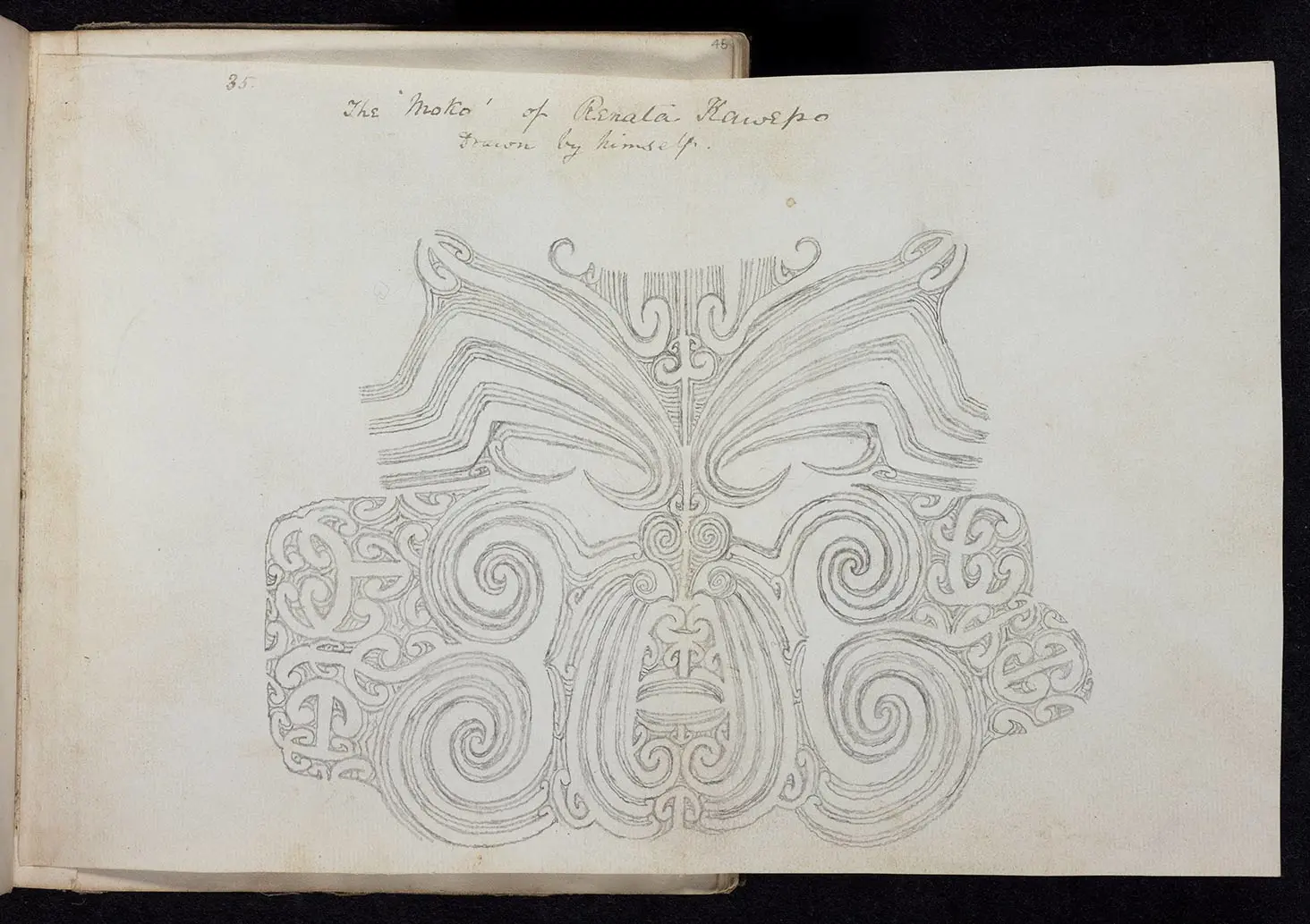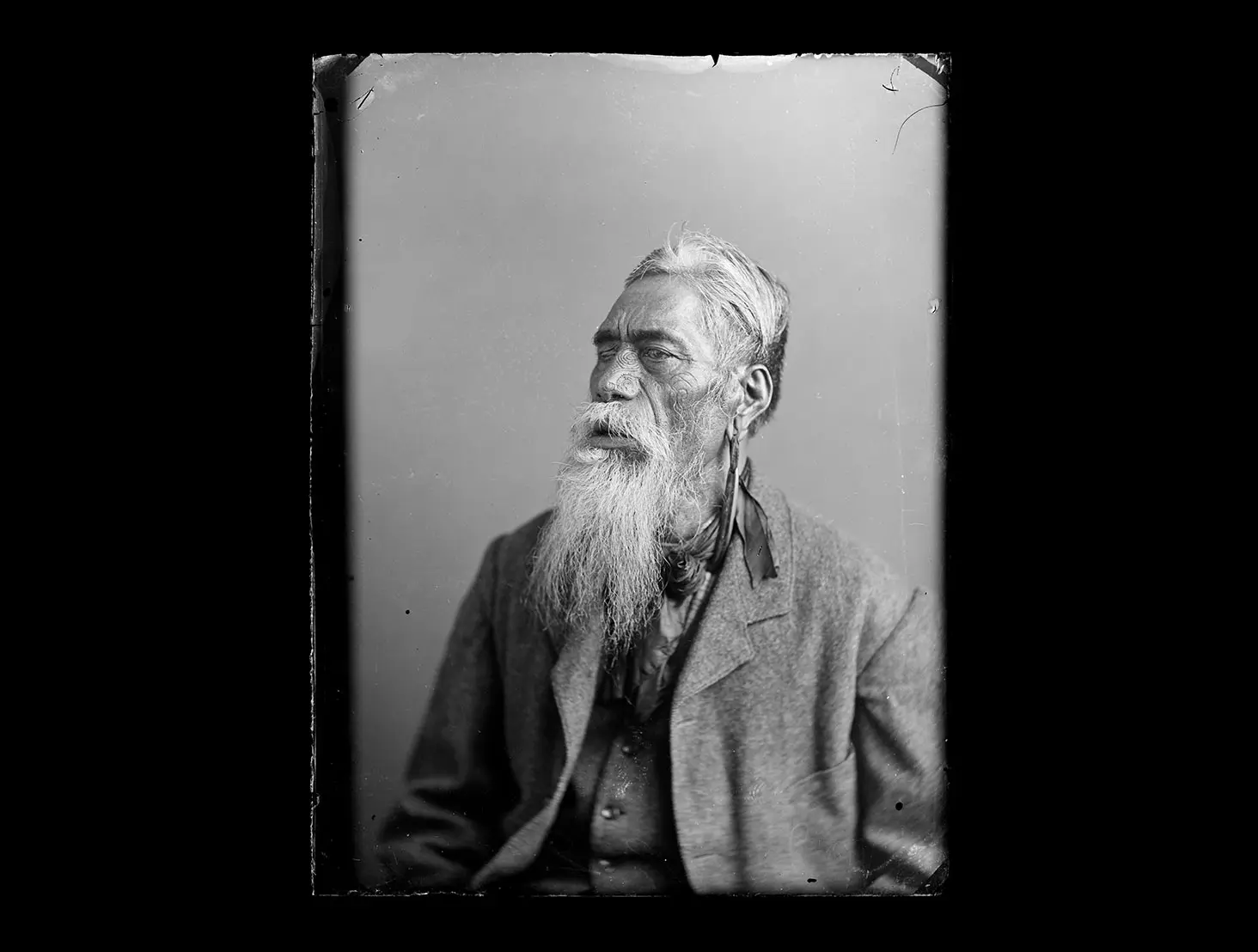Image credit: The ‘Moko’ of Renata Kawepo, Drawn by Himself, ca 1844 by Rēnata Tama-ki-Hikurangi Kawepō. Ref: E-111-1-044 Alexander Turnbull Library.

Image credit: The ‘Moko’ of Renata Kawepo, Drawn by Himself, ca 1844 by Rēnata Tama-ki-Hikurangi Kawepō. Ref: E-111-1-044 Alexander Turnbull Library.

Rēnata Tama-ki-Hikurangi Kawepō was highly respected by both Māori and Pākehā. He was an extraordinary rangatira, missionary and writer in a time of great historical change. Find out more, and explore our collections and curated resources.
This extraordinary drawing, almost life-size, is of the facial moko of Rēnata Tama-ki-Hikurangi Kawepō (Ngāti Te Upokoiri, Ngāti Kahungunu; 1808?–1888), drawn by Kawepō himself. It features in one of three sketchbooks created by the missionary Thomas Biddulph Hutton (1824–1886) between 1844 and 1846. These sketchbooks, donated to the Turnbull Library in 2016, record Hutton’s experiences in Aotearoa New Zealand, a country on the threshold of colonial change, and include portraits of Māori, church architecture, botanical drawings and images of Māori and Pākehā social life.
Kawepō was a rangatira and a Christian missionary. He had learned to write in English as a youth and was able to instruct the missionaries he knew in the Māori language. Hutton arrived in New Zealand in 1842 and would have encountered Kawepō when he met with Reverend William Charles Cotton, chaplain to the first Anglican Bishop in Aotearoa New Zealand, George Augustus Selwyn.
Kawepō travelled with the clerics as guide and interpreter in their visits to missionary posts throughout New Zealand during 1843–44. Both Cotton and Hutton drew Kawepō in their sketchbooks, and Kawepō recorded his own account of their arduous journey, Ko te Haerenga o Rēnata (Rēnata’s Journey), almost certainly the earliest of this type of document to be written by a Māori in te reo Māori. His manuscript is held with the journals of William Cotton in the State Library of New South Wales; the Turnbull Library holds a copy on microfilm. Volume IV of Cotton’s journals also includes a self-executed drawing of Kawepō’s moko, for the purpose of basic instruction in the art of tā moko.
In 1869, more than 20 years after the drawing in Hutton’s sketchbook was made, Kawepō’s right eye was gouged out in an act of vengeance by the young widow of a chief who had been killed during the capture of Te Pōrere pa, in which Kawepō had participated. Rather than punishing her, Kawepō decided her act was a fair one and protected her; she later became his wife. Although he was known for wearing a patch over his missing eye, he was on numerous occasions photographed in later life without it.
When Kawepō died at Ōmāhu in Heretaunga on 20 April 1888, 6000 people attended his tangi. He had been highly regarded by both Māori and Pākehā for his open-mindedness and fair judgment, and a monument to him was erected at Ōmāhu a year after his death.
Story written by: Denise Roughan
Copyright: Turnbull Endowment Trust
Thomas Hutton’s New Zealand sketchbooks stayed with his family in England until 2016, when Mayo Marriott, a descendant of Hutton’s second wife, donated them to the Turnbull Library.
Carte de visite portrait of Rēnata Tama-ki-Hikurangi Kawepō, Napier, early 1880s by Samuel Carnell. Ref: 1/4-022223-G Alexander Turnbull Library.

This photograph of Kawepō was probably the basis for Gottfried Lindauer’s 1885 painting of him, held at the Auckland Art Gallery Toi o Tāmaki.
Explore the Alexander Turnbull Library collections further:
Topic Explorer has Māori history post-European arrival.
Many Answers has Māori culture and customs.
Want to share, print or reuse one of our images? Read the guidelines for reusing Alexander Turnbull Library images.
Tikanga ā-iwi:
Te whakaritenga pāpori me te ahurea
Te ao hurihuri
Te wāhi me te taiao.
Te Takanga o Te Wā (ngā hītori o Aotearoa):
Whakapapa
Tūrangawaewae
Mana motuhake.
Social sciences concepts:
Identity, culture, and organisation
Place and environment
Continuity and change.
Aotearoa New Zealand’s histories:
Māori history is continuous
Colonisation and its consequences
Relationships and connections between people.